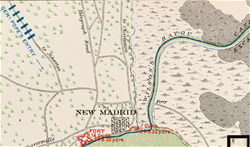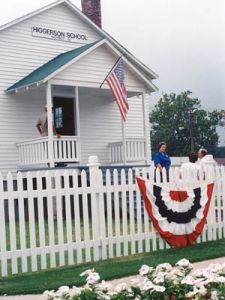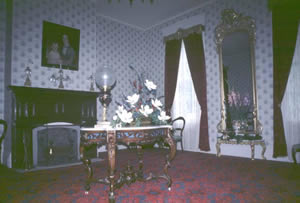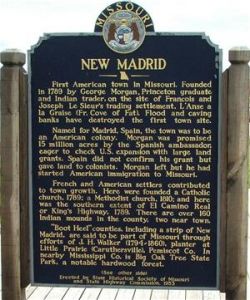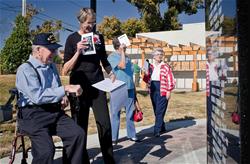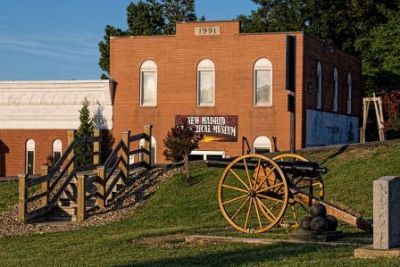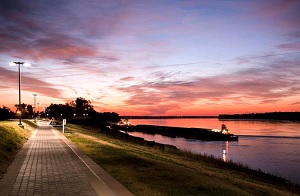Things To Do
LEADING UP TO BATTLE
With the surrender of Fort Henry and Fort Donelson in Tennessee, and the evacuation of Columbus, Kentucky, General P.G.T. Beauregard, commander of the Confederate Army of the Mississippi, chose Island Number 10, which stood about 10 feet above the low water mark, had 30 guns and was about 60 river miles below Columbus, to be the strong point for defending the Mississippi River.
Nearby was New Madrid, Missouri, one of the weak points. Brigadier General John Pope, commander of the Union Army of the Mississippi, left from Commerce, Missouri, to attack New Madrid, on February 28, 1862. His force of men marched overland through swamps, lugging supplies and artillery, reaching the outskirts of New Madrid on March 3, and laid siege to the city. Brigadier General John P. McCown, the garrison commander, defended both New Madrid and Island Number 10 from the fortifications at Fort Thompson and Fort Bankhead, which housed a total of 21 heavy guns. He launched a sortie, under Brigadier General M. Jeff Thompson, Missouri State Guard, against the besiegers and brought up heavy artillery to bombard them.
BOMBARDMENT
On the 13th, four 128-pound siege guns arrived and the Union set about in earnest to bombard the forts and the fleet of gunboats. The Confederates bombarded the Yankees to no avail. Since it did not appear possible to defend New Madrid, the Confederate gunboats and troops evacuated to Island Number 10 and Tiptonville, Tennessee.
On the 14th, Pope's army discovered that New Madrid was deserted and moved in to occupy it. A Union Navy flotilla, under the command of Flag Officer Andrew H. Foote, arrived March 15, upstream from Island Number 10.
DIGGING A BYPASS CANAL
During this time Foote thought it would be suicide to run ironclads past Island Number 10 so Pope ordered a shallow canal dug to bypass the hairpin curve of Island Number 10 and come out just east of New Madrid thus bypassing the batteries. The canal was 50 feet wide and 12 miles long with 6 miles cut through heavy timber where every tree had to be sawed off 4½ feet below water. This remarkable event was completed in 19 days while Island Number 10 Confederate soldiers endured day and night shelling. By April 4th, it was possible to ferry shallow-draft troop transports down to Pope at New Madrid.
IRONCLADS SNEAK PAST ISLAND NUMBER 10
On the night of April fourth, during a thunderstorm the Ironclad Carondelet with a coal barge lashed to the port side for protection ran the Island Number 10 batteries, receiving only two hits in the process, and anchored at New Madrid at dawn. The Ironclad Pittsburg followed on the night of April sixth.These ironclads helped to overthrow the Confederate batteries and guns, enabling Pope's men to cross the river and block the Confederate escape route.
Brigadier General William W. Mackall, who replaced Major General John P. McCown, surrendered Island Number 10 at 2 a.m. on the morning of April 8, 1862 to Foote.
Pope reported an incredible haul of prisoners and equipment that included the capture of three generals, 273 field and company officers, 6,700 privates, 123 pieces of heavy artillery and an immense supply of ammunition and small arms. All this had been accomplished with fewer than hundred causalities on the Union side.
The Mississippi River was now open about 50 miles downriver to Fort Pillow, Tennessee with the Union victory. New Madrid and Island Number 10 was the Confederate's last stronghold in the State. No rebel flag was now flying in Missouri.
ISLAND NUMBER 10 TODAY
Island Number 10 has since disappeared as a result from erosion from the Mississippi River and is now located on the Missouri side of the river near Donaldson Point.
CIVIL WAR ARTIFACTS
Civil War enthusiasts will be particularly interested in the Civil War Room located in the New Madrid Historical Museum. Letters, clothing, equipment and weaponry of the period are all on display, much of it donated by local residents with family connections to the pieces.
The Battle of Island Number 10 is presented from the viewpoint of a local historian and the Gift Shop carries an excellent selection of books on the period.
WebsiteRestored to the one-room school that operated at Higgerson Landing in 1948, the Higgerson School is a window to the educational practices that shaped and served rural America from the early 19th century
Experience the typical school day of youngsters attending all eight grades in one room with one teacher. Relive the days of playing "Wolf Over and River" and "Caterpillars," a trip to the outdoor facility and crossing the fence on the stile.
WebsiteELEGANT MANSION
The white antebellum Hunter-Dawson Home State Historic Site reflects the splendor of the elegant mansions that once were a common site along the Great River Road, and represents yet another generation that carved a home out of the rich Bootheel wilderness.
LOCATION
Because of its location on a bend in the Mississippi River, New Madrid had become a busy trading center for traffic on the river. Just like the prehistoric Indian town of Towosahgy, New Madrid in the 19th century depended upon the river for its economic life.
HISTORICAL BACKGROUND
William Washington Hunter, a Virginian who moved to the area in 1830, became a successful businessman and acquired a large section of land north of the town. Here he picked the setting for his new home among the giant oaks and gum trees, many of which remain today.
OLD ECLECTIC STYLE
The Hunter-Dawson house is a two-story, 15-room frame structure of an eclectic style with Georgian, Greek Revival and Italianate influences. The lumber used in the house is mostly yellow cypress, which local and family tradition states came from a nearby sawmill owned by Hunter. The labor during construction was furnished by Hunter's own slaves and by area craftsmen. One of the workers, Matt Imboden, was particularly skilled in brick masonry, as evidenced by the nine fireplaces within the house.
FURNITURE COLLECTION
The majority of furnishings for the house were purchased from the Cincinnati firm of Mitchell and Rammelsberg, probably from its St. Louis outlet. The furniture, which remains in the house, was then shipped to New Madrid by steamer. It is believed that the furniture is the largest collection of an original Mitchell and Rammelsberg setting.
For admission costs and hours of operation please call 573-748-5340
WebsiteCITY'S NAME & FOUNDATION
First American town in Missouri. Founded in 1789 by George Morgan, Princeton graduate and Indian trader, on the site of Francois and Joseph LeSieur's trading settlement, L'Anse a la Graise (Fr. Cove of Fat). Flood and caving banks have destroyed the first site.
Named for Madrid, Spain, the town was to be an American colony. Morgan was promised 15 million acres by the Spanish ambassador, eager to check U.S. expansion with large land grants. Spain did not confirm his grant, but gave land to colonists. Morgan left but he had started American immigration to Missouri.
TOWN EXPANSION
French and American settlers contributed to town growth. Here were founded a Catholic church, 1789; a Methodist church, 1810; and here was the southern extent of El Camino Real or King's Highway, 1789. There are over 160 Indian mounds in the county, two near towns.
"Boot Heel" counties, including a strip of New Madrid, are said to be part of Missouri through efforts of J. H. Walker (1794-1860), planter at Little Prairie (Caruthersville), Pemiscot Co. In nearby Mississippi Co. is Big Oak Tree State Park, a notable hardwood forest
THE 1811-1812 EARTHQUAKES
The New Madrid Earthquake, made up of a series of monstrous and lesser quakes, which began December 16, 1811, and continued over a year, centered here. One of the great earthquakes of the world because of severity and length it caused little loss of life in a thinly settled region. Some of the shocks were felt as far as 1100 miles. Reelfoot Lake across the river is a result of the disaster. New Madrid land certificates, good for public land elsewhere, were provided sufferers by the U.S. relief act, 1815, which benefited mostly speculators.
ON THE CIVIL WAR
In 1862 Union forces captured New Madrid and by means of a canal sawed through a submerged forest to a bayou, gained control of island number 10 and command of the river. Nearby in Mississippi Co. is Belmont battlefield, scene of an 1861 engagement in which both Federal forces under Grant and Confederates under Pillow claimed victory.
AGRICULTURAL PRODUCTION
New Madrid, seat of government of one of five Spanish districts, later one of Missouri's first five counties, serves a farming community. Cotton and soybean crops preodominate. Rich land has been reclaimed by the Little River and St. John Levee drainage systems.
WebsiteNEW MADRID COUNTY VETERANS PARK DEDICATION
An estimated crowd of 300 plus attended the dedication services held Thursday, November 11, 2010 for the newly constructed Veterans Park. The program began at 10 a.m. with music provided by the New Madrid County Central High School Band. Master of Ceremonies was New Madrid County Mayors Association President, Donnie Brown.
Rev. Jeffrey Long, New Madrid First United Methodist Church, gave the invocation. The New Madrid County Central JROTC posted the colors followed by the Pledge of Allegiance. The New Madrid County Central Singing Eagles sang the National Anthem and " Salute to the Armed Forces." Speakers were Clyde Hawes, New Madrid County Presiding Commissioner, Steve Hodges, District 161 State Representative and Judy Thrower, Case Specialist for Congresswoman Jo Ann Emerson's Office. Adam Young, senior at NMCC, read his original poem honoring veterans followed by the raising of the American, Missouri, KIA/MIA and POW flags.
The service was closed with a benediction by Rev. Ed Thomason, New Madrid Church of Christ, followed by a 21 Gun Salute by the Richard Grissom Color Guard of American Legion Post No. 595.
The Veterans Park was envisioned and planned by the River Bend Botanical Society in partnership with the New Madrid City Council, New Madrid County Commissioners and the New Madrid County Highway Department as a place of honor for veterans and their families. Finance for the park came from numerous fundraiser events as well as donations from individuals, organizations and area businesses.
WebsiteLocated on the Mississippi River in the former Kendall Saloon at the foot of Main Street, the New Madrid Historical Museum reflects the history of this river town from the Mississippian period up through the early 20th century. The great earthquakes of 1811 and 1812 are well documented in the Museum's collections as is the potential for future seismic activity.
Other exhibits include the story of the Battle of Island #10 during the Civil War, and the story of the Mississippians, who occupied the New Madrid area for several centuries at what is now known as the Lilbourn Fortified Village Site.
The New Madrid Historical Museum is open 7 days a week, 358 days a year! Our hours vary slightly- It is 9am-5pm Mon-Sat and 12pm-5pm on Sunday from April thru November. December thru March it's 10am-4pm Mon-Sat and 12p-4p Sunday.
We are closed Thursday and Friday of Thanksgiving week, Christmas Eve & Day, New Years' Eve & Day and Easter Sunday.
Admission is $5 for adults and $3 for students under 18. 6 and under are free
WebsiteOnly three minutes off Interstate-55, the Mississippi River Walk and Observation Deck offer panoramic views of the greatest waterway in North America. Enjoy a leisurely 1/5 mile walk from the Riverside Park to the Observation Deck.
Take advantage of several observation benches along the way, set a spell and let your mind move with the river.
See eight miles of the river as it winds around the New Madrid Bend, a point of strategic significance during the Civil War.
The River Walk is handicapped accessible and is open daily at all hours.
Website
